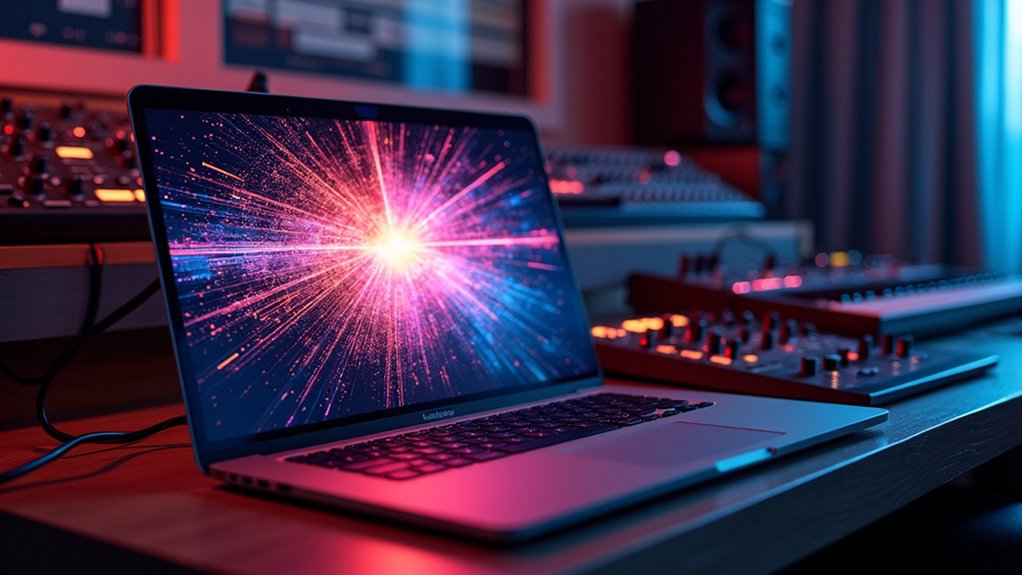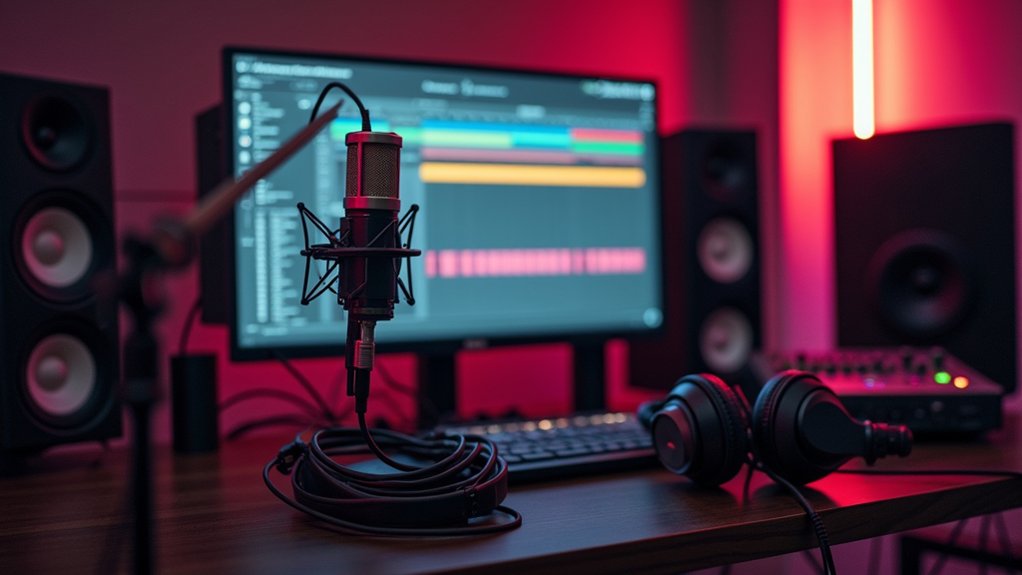To tune instruments in Ableton Live, load the Tuner device onto an audio or MIDI track to monitor pitch visually in real time. Adjust pitch until the detected note matches the desired key. Use the Spectrum device for frequency analysis or tune drums by referencing a sine wave generated by Operator. For non-standard tunings, import Scala files to implement alternative systems. Applying these precise techniques guarantees harmonic alignment—further workflow enhancements await in the thorough guide.
Key Takeaways
- Insert Ableton’s Tuner device on each audio or MIDI channel to visually monitor and correct instrument pitch in real time.
- Adjust the detected pitch using the Tune or Transpose controls on your instrument or sample until the Tuner displays the desired note.
- Set the concert pitch A parameter in the Tuner to match your project’s reference tuning if using alternative standards.
- For drum samples, use the Tuner or Spectrum device to identify and tune tonal elements to your track’s key or root note.
- Use Max for Live tuning tools or import Scala files for advanced or alternative tuning systems within Ableton Live.
Understanding the Importance of Tuning in Ableton Live
Although often overlooked in digital music production workflows, precise tuning in Ableton Live is a critical step for achieving a coherent and professional sound. Tuning guarantees that all MIDI instruments, audio samples, and external sources align with the project’s reference pitch, creating a harmonically unified mix.
Within Ableton Live, adjusting the reference pitch allows users to calibrate the tuning system to match different tuning standards or artistic requirements. A loaded tuning system can facilitate creative departures from conventional concert pitch, supporting genres or tracks that benefit from alternative tunings.
Employing the Tuner device to monitor pitch accuracy across instruments mitigates phase and frequency clashes, improving mix clarity. Consistently referencing the project’s tuning parameters guarantees seamless integration of new elements and supports professional production standards throughout the workflow.
Using the Tuner Device for Accurate Instrument Tuning
A key utility in Ableton Live’s workflow, the Tuner device offers a precise, visual method for monitoring and correcting the pitch of audio signals in real time.
Its highly visual interface displays the detected notes, enabling users to match tonal instruments to the intended tuning system. The adjustable concert pitch A parameter supports alternative standards, accommodating orchestral or modern settings.
For MIDI notes, the Tuner device allows direct feedback on pitch accuracy, essential when working with synths or external hardware with variable pitch bend ranges.
Multiple view modes enhance workflow flexibility, giving clear insights into subtle deviations during instrument tuning.
Monitoring in real time, users can quickly achieve harmonic alignment within the mix, streamlining the process of integrating diverse sources with consistent pitch.
Step-by-Step Guide to Tuning Drums and Samples
When preparing drum sounds or samples for use in a production, precise pitch alignment is essential for achieving cohesive harmonic relationships within the mix.
Initiate by loading your drum sample into a Drum Rack or directly onto an Audio Track. Engage the Tuner device in the Tuning section to visually analyze the pitch of tonal elements—such as kicks or toms—especially when drawing from the Core Library.
For detailed frequency analysis, utilize the Spectrum device to pinpoint the fundamental, then fine-tune using Detune controls or a Frequency Shifter in Shift mode.
When tuning by ear, route a MIDI track with Operator’s sine wave, triggered via a MIDI Controller, to match pitches.
Enable the Retune Set On Loading option to maintain tuning consistency across sessions, ensuring all drum samples remain harmonically integrated.
Exploring Alternative Tuning Systems in Ableton Live
Beyond tuning individual drums and samples for harmonic coherence, Ableton Live supports advanced pitch manipulation through alternative tuning systems. Users can import different tuning systems by loading Scala files (.scl or .ascl), expanding creative possibilities beyond the standard 12-tone equal temperament.
Once a tuning system is loaded, Live instruments and MIDI tracks conform to the chosen pitch structure. Practical workflow enhancements include:
- Loading SCL Files: Drag .scl or .ascl files into the Tuning section to instantly apply a new tuning system.
- Custom Controller Integration: Use the Track Tuning options to define custom MIDI controller layouts, ensuring external keyboards map accurately with alternative tunings.
- Bypass Tuning Toggle: Selectively enable or disable alternative tuning for specific tracks or instruments, allowing seamless integration of differently tuned and standard elements within a session.
Tips for Achieving a Cohesive Mix With Proper Tuning
Ensuring all instruments are precisely tuned to the track’s key establishes a solid harmonic foundation, minimizing unwanted dissonance and facilitating a more unified mix.
Within an Ableton Live Set, initiate workflow by inserting the Tuner device onto each audio channel when tuning instruments. Leverage the real-time visual feedback to match each instrument’s pitch to the project’s root note, addressing any different pitch discrepancies immediately.
For drum elements, tune samples to the tonic or perfect fifth for ideal integration with the melodic context, enhancing overall cohesiveness.
Utilize Max for Live tools for advanced tuning or for loading alternative tuning systems, ensuring consistency across diverse sound sources.
Systematically repeating this process throughout the Live Set considerably raises the professional quality and coherence of the final cohesive mix.
Frequently Asked Questions
How to Use a Tuner in Ableton?
To use a tuner in Ableton, users load the device, select appropriate tuner settings, and engage real time monitoring. Visual feedback aids pitch detection across instrument types. Calibration methods and tuning algorithms optimize accuracy, supporting broad frequency range adjustments during the tuning process.
How to Do Auto Tune on Ableton?
Auto tune in Ableton involves configuring auto tune settings within plugin options, applying pitch correction for vocal enhancement, utilizing MIDI tuning for melody adjustment, integrating effects for real time tuning, and optimizing workflow for seamless tuning and precise pitch control.
How Do I Tune My Guitar in Ableton Live 11?
For guitar tuning techniques in Ableton Live 11, users employ software tuning plugins, configure audio input settings for string instrument calibration, utilize pitch correction methods, and monitor tuning guitar effects during live performance tuning or when recording guitar tracks for accuracy.
How to Tune Music to 432 Hz Ableton?
Tuning music to 432 Hz in Ableton involves digital tuning methods, pitch adjustment of audio, and tuning plugins for audio calibration. This workflow aligns with 432 Hz benefits, frequency theory, musical harmony, and sound healing principles for enhanced resonance.
Conclusion
Proper tuning in Ableton Live streamlines the production workflow, ensuring instruments and samples align harmonically. Utilizing the Tuner device allows rapid pitch detection and adjustment, while exploring alternative tuning systems can unleash creative potential. Consistent tuning across tracks prevents frequency clashes and yields a more cohesive mix. By integrating precise tuning techniques into the standard workflow, producers maintain sonic accuracy and achieve professional results, ultimately enhancing both the technical quality and musicality of their projects.




